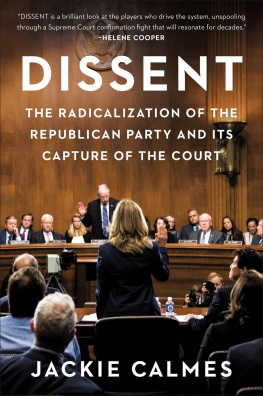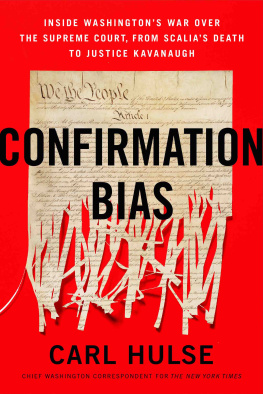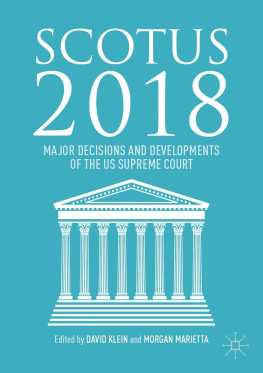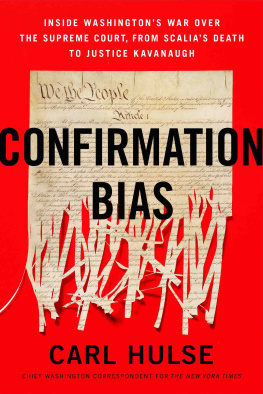Copyright 2019 by Mollie Hemingway and Carrie Severino
All rights reserved. No part of this publication may be reproduced or transmitted in any form or by any means electronic or mechanical, including photocopy, recording, or any information storage and retrieval system now known or to be invented, without permission in writing from the publisher, except by a reviewer who wishes to quote brief passages in connection with a review written for inclusion in a magazine, newspaper, website, or broadcast.
Regnery is a registered trademark of Salem Communications Holding Corporation
Cover design by John Caruso
Authors photos by Jerry Frishman
Cataloging-in-Publication data on file with the Library of Congress
ISBN 978-1-62157-983-0
ebook ISBN 978-1-62157-984-7
Published in the United States by
Regnery Publishing
A Division of Salem Media Group
300 New Jersey Ave NW
Washington, DC 20001
www.Regnery.com
Books are available in quantity for promotional or premium use. For information on discounts and terms, please visit our website: www.Regnery.com.
To Our Lady of VictoryCCS
To MarkMZH
CHAPTER ONE
The Primary
W ith a rap of his gavel on June 27, 2018, Chief Justice John Roberts declared another Supreme Court term over, and the nine justices disappeared behind the dark red curtains that hang behind the bench. The assembled journalists politely stood at attention until the last justice was out of view, then rushed to file stories about a non-eventno justice had announced his retirement. Speculation had been running high that Justice Anthony Kennedy, appointed by President Ronald Reagan and nearly eighty-two years old, would be leaving now that a Republican again occupied the White House. Senator Charles Grassley of Iowa had publicly advised the justices in early May that if they were thinking about quitting this year, do it yesterday. Grassley, and the powerful Senate Judiciary Committee he chaired, would have to manage the intense confirmation process, and with the midterm elections looming, they would need all the lead time they could get.
The members of the Court retired to their private dining room for the traditional end-of-term luncheon before they dispersed for the summer. As they dined, an armored black car, dispatched from the White House Military Office, pulled into the parking garage three floors below them. After his meal, Justice Kennedy got into the car, where Don McGahn, the White House counsel, was waiting to take him to a meeting with President Trump.
It was a busy day at the White House, the president having held a mid-morning press conference on trade policy and the economy on the South Lawn. After lunch with Secretary of State Mike Pompeo, he would host President Marcelo Rebelo de Sousa of the Republic of Portugal. The press usually lingered around the famous but surprisingly small briefing room at the north side of the mansion, hoping to catch additional stories or details from their White House contacts.
The day before, Steve Engel, the head of the Justice Departments Office of Legal Counsel, had told McGahns trusted chief of staff, Annie Donaldson, that he had just had a meeting with his old boss and needed to talk to McGahn. It took a minute for the significance of what hed said to register. Engels old boss was Anthony Kennedy. Hed clerked for him at the Supreme Court in 20012002, and they had remained close.
Engel and Kennedy had met two days before the end of the term at an outdoor caf near the National Gallery of Arts Sculpture Garden. Kennedy had slipped away from a tour of the museum with his clerks to meet Engel, hoping the location was discreet enough to avoid wandering members of the press. After the justices security detail evaluated the caf for threats, he sat down with Engel and explained that he expected to announce his retirement in the next few days. He wanted to tell his fellow justices immediately after their final sitting on Wednesday but knew the odds were good that the news would leak shortly thereafter.
Hoping to deliver the message to the president in person before it went public, Kennedy wanted Engel to ask McGahn to arrange a meeting without anyones noticing. Later that day, Engel called the White House counsels office and asked about the presidents schedule. The two offices spoke frequently, so the question didnt arouse suspicion. He was told the president was leaving for the Midwest on Wednesday evening, so the meeting would need to happen before then.
The next day, Kennedy gave Engel the green light, and the White House counsels office quietly arranged the meeting through Jeffrey Minear, counsel to Chief Justice Roberts. A White House car with a pre-cleared driver would make the entry into the White House quick and easy. Chief of Staff John Kelly arranged for President Trump to leave his lunch promptly at one oclock and come to the White House residence, where the justice would be waiting with McGahn.
That morning, none of the other associate justices knew that Kennedy was stepping down. The scholarly Californian, known as a swing vote on the Court, had hired four clerks for the coming year and had discussed cases coming up in the next term. When the term ended with no announcement from the bench, the justices proceeded to their stately, paneled conference room for one final discussion.
While the nine justices often disagree sharply about the issues before the Court, they know they are working together for life, so they go out of their way to be friendly to one another. But the last conference of each term tends to be a bit testier. The most contentious decisions are usually released in the final days of the term, justices sometimes reading their fiery dissents from the bench, and the 20172018 term ended with its share of high-profile five-to-four decisions on such hotly debated subjects as abortion and immigration.
When the justices had concluded their businessvoting on the disposition of cases related to their recent decisionsKennedy informed his shocked colleagues that he had decided to retire. He asked them to not tell anyone until two oclock so he could speak with the president privately.
No one from the press noticed Kennedys arrival at the Executive Residence, which was chosen for the meeting because of its relative privacy. The Oval Offices large bank of windows makes it a fishbowl for prying eyes. Kennedy and Trump chatted pleasantly for about twenty minutes until, feeling the time was right, the justice handed the president an envelope. Inside was a letter dated June 27, 2018, beginning, My dear Mr. President, a sign of the genuine affinity, as one observer put it, that the two men had for each other. The letter was Kennedys formal announcement of his resignation.
President Trump was surprised by Kennedys retirement but not unprepared. He had heard rumors the previous year that after more than But many conservatives simultaneously supported his approach to federalism and the First Amendment, particularly as it concerns free speech. The White House indicated to him that his record would be treated respectfully and that his successors confirmation battle would not be a referendum on his tenure. When the White House got word that Kennedy was displeased one of its nominees for an obscure federal court had called him a judicial prostitute, the nomination was allowed to expire.
The stature of a justice is measured not only by the influence of his legal opinions but also by the careers and reputations of the clerks he has handpicked and mentored. The White House had sought Kennedys opinion about his former clerks who were under consideration for the federal judiciary and had nominated several of them to prestigious appeals courts. Most flattering of all, Trump had chosen one of Kennedys star former clerks, Neil Gorsuch, to join him on the Supreme Court one year earlier.
Next page





